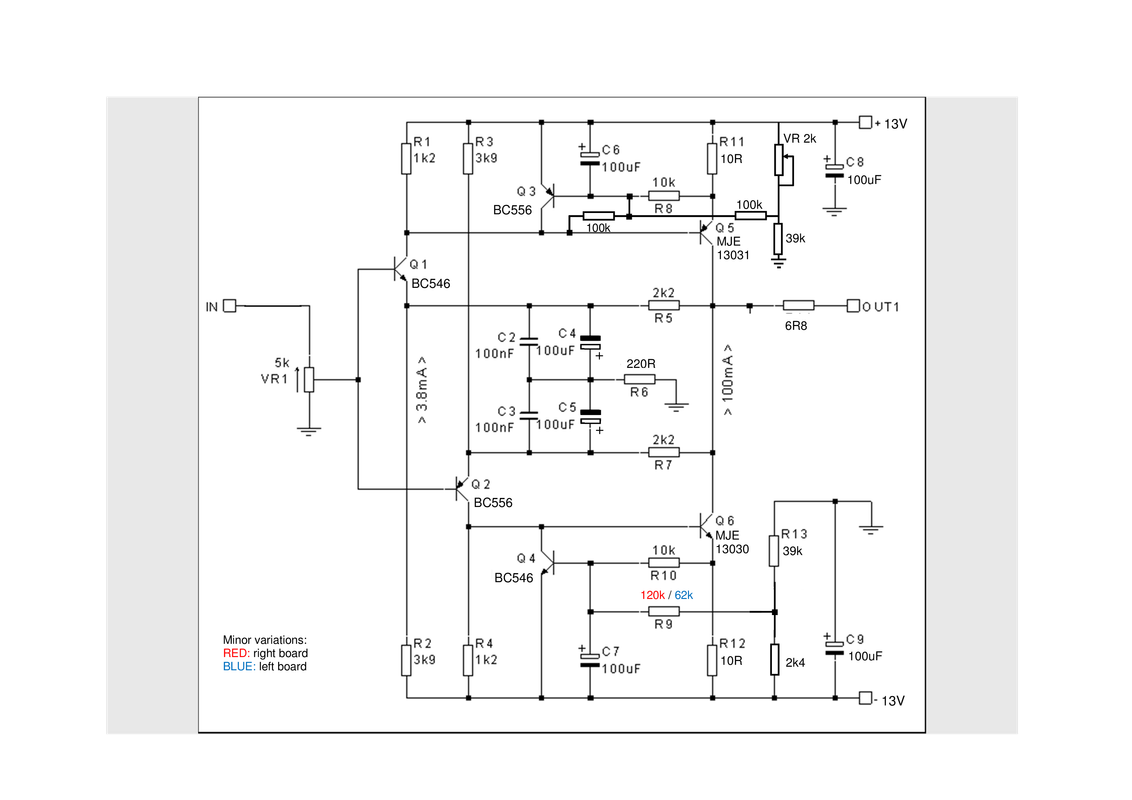a.palfreyman
pfm Member
This one, Circuit 2:
https://sound-au.com/tcaas/jlhphones.htm
Built it over Christmas. You can JUST cram one circuit on a 9 rows x 25 holes piece of strip-board.
One comment re the circuit diagram: C4 and C5 are the wrong polarity and should be inverted.
I used BC546 / 556 for Q1/2; BC547 / 556 for Q4/3 and MJE15030/31 for Q6/5 as that is what I had to hand.
PSU: 12+12V 20VA transformer, 1N4004 bridge rectifier, 3x1000uF caps in parallel per rail with a 220R feeding a 12V zener and yellow LED in series to give 14V reference, zener and LED bypassed with 100uF cap which provides the base voltage to NPN / PNP cap multiplier. Output +/-13.3V was originally a little noisy (a slight 100Hz buzz), but has settled down after some use (will scope over w/end).
This is settling in nicely, driving DT990 'phones (slightly modified). The mid is nice and open, the bottom is full, tuneful and well defined, and the top is a bit peaky, but that's DT990's for you!
One question re DC offset: I was getting a large drift (200mV negative over about 3-4 hours) on first use, but now this is down to about 70mV (I guess this is the caps forming / settling in). I have it set to +50mV just after switch-on and this slowly drifts to -20mV after about 3 hrs use, mainly due to heat from the transformer, which I'm guessing is about 10W as the frame is warm but not hot to touch. Can this drift be improved upon? The reason I ask is I would also like to try a voltage divider across the output to see how it sounds working as a pre-amp, although a voltage divider (say 1k and 330R) with a final output cap of circa 3,3uF at the junction of the two resistors would suffice. Thoughts?
AP
https://sound-au.com/tcaas/jlhphones.htm
Built it over Christmas. You can JUST cram one circuit on a 9 rows x 25 holes piece of strip-board.
One comment re the circuit diagram: C4 and C5 are the wrong polarity and should be inverted.
I used BC546 / 556 for Q1/2; BC547 / 556 for Q4/3 and MJE15030/31 for Q6/5 as that is what I had to hand.
PSU: 12+12V 20VA transformer, 1N4004 bridge rectifier, 3x1000uF caps in parallel per rail with a 220R feeding a 12V zener and yellow LED in series to give 14V reference, zener and LED bypassed with 100uF cap which provides the base voltage to NPN / PNP cap multiplier. Output +/-13.3V was originally a little noisy (a slight 100Hz buzz), but has settled down after some use (will scope over w/end).
This is settling in nicely, driving DT990 'phones (slightly modified). The mid is nice and open, the bottom is full, tuneful and well defined, and the top is a bit peaky, but that's DT990's for you!
One question re DC offset: I was getting a large drift (200mV negative over about 3-4 hours) on first use, but now this is down to about 70mV (I guess this is the caps forming / settling in). I have it set to +50mV just after switch-on and this slowly drifts to -20mV after about 3 hrs use, mainly due to heat from the transformer, which I'm guessing is about 10W as the frame is warm but not hot to touch. Can this drift be improved upon? The reason I ask is I would also like to try a voltage divider across the output to see how it sounds working as a pre-amp, although a voltage divider (say 1k and 330R) with a final output cap of circa 3,3uF at the junction of the two resistors would suffice. Thoughts?
AP


